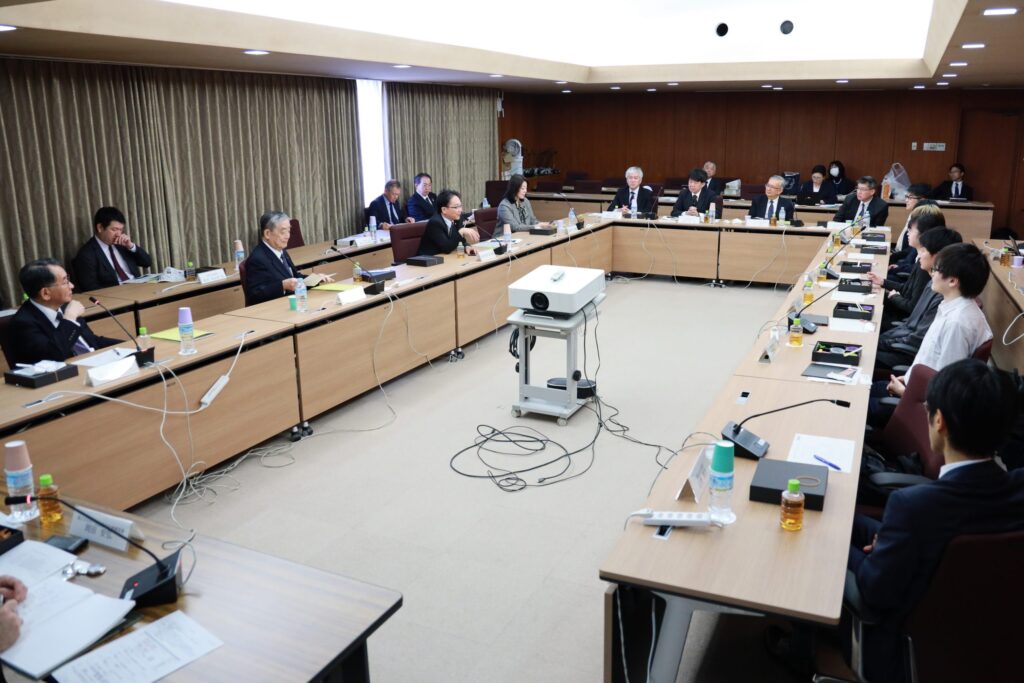
On 13 November last year, four Japan’s Federation of Diet Members for the International Linear Collider (ILC) visited KEK. The group included Ryu Shionoya, Chairperson of the Caucus, member of the House of Representatives and former Minister of Education, Culture, Sports, Science and Technology (MEXT); Keitaro Ohno, member of the House of Representatives and Secretary-General of the Diet Members Caucus; Shinsuke Okuno, also a member of the House of Representatives, and Megumi Hirose, member of the House of Councilors. KEK Director General Masanori Yamauchi provided an overview of KEK’s research activities, after which the group toured the experimental facilities for about an hour.
The delegation’s first stop was at the Superconducting RF Test Facility (STF). The STF is a facility for developing and testing superconducting radio frequency (SCRF) accelerating cavities, which accelerate electrons and positrons to near the speed of light. The STF also plays a vital role in testing the SCRF accelerating system, which is one of the crucial technologies for realizing the ILC. Since producing 9,000 superconducting accelerating cavities is essential for the ILC, KEK is also working hard to improve the quality of these cavities and find ways to achieve efficient mass production.
The next stop was the Advanced Accelerator Test Facility (ATF), where researchers from around the world collaborate to develop technology to generate and precisely control the extremely small beams required for the ILC. ATF is the only facility of its kind.
The particle beams to be used for the ILC experiments will consist of bunches of 20 billion electrons or positrons. Although there are 20 billion particles inside, they are so tiny that the bunches are mostly empty. Scientists are cramming particles into nano-sized beams to increase particle density and, thus, collision efficiency. ATF has already achieved a beam size of 41 nanometers (41 millionths of a millimeter). This is a world record. The international team of scientists will continue researching to narrow the beam size further and develop techniques to maintain stable beam collisions.
Their final destination was the SuperKEKB accelerator and the Belle II detector, where physics experiments are currentry conducted. The accelerator collides electrons and positrons, the same particles to be used at the ILC. Both projects have the same mission to explore the mysteries of the beginning and laws of the universe, but their approaches are different. While the ILC aims for collisions at very high energies, the Belle II experiment aims to find very rare phenomena with the help of very high luminosity. When the ILC becomes a reality, both would complement each other. The Belle II International collaboration started taking data in 2019, searching for new physical phenomena beyond the standard model of particle physics.
During the tour, curious attendees asked many questions, such as the technology being developed for the ILC and their potential for applications or R&D activities during COVID-19. They all seemed genuinely impressed, and Shionoya said, “I regret not coming earlier. I hope you will share this research with the world, highlighting its greatness”.
Following the tour of the facility, the delegations had a discussion with six graduate students of particle physics and accelerator science from the International Center for Particle Physics (ICEPP) at the University of Tokyo and the Graduate University for Advanced Studies (SOKENDAI).
Keitaro Ohno asked graduate students about their ambitions for the future. Yuki Abe of SOKENDAI, who is working on the research at the ATF, said he has been attracted to the accelerator, the precision machine. “I would like to be involved in research from a manufacturing perspective. My ambition is that the device I am currently developing will be implemented in the ILC in the future.”
Shinsuke Okuno inquired about the best way to describe the ILC. “ If you have good ideas, please share them with us. We would like to use it when explaining about the ILC.” The students said they often struggle to explain their work to friends and family. Some presented the ILC as a stepping stone toward understanding the underlying principles of physics, and others explained the ILC as a machine to recreate the Big Bang or the experiments to learn what we don’t know now. After listening to the students’ opinions, Okuno commented that it would be easier to understand if they were explained using analogies related to daily life.
From the student side, sincere wishes were expressed to the delegation. The students told the reality of the situation: due to the limited number of openings in particle research in Japan, they are either forced to continue their research abroad or give up their academic career to work in the industry. They emphasized the significance of having places and opportunities to apply the advanced expertise obtained during graduate school.
Ryu Shionoya stated that the slogan used by ITER “地上に太陽を(A Small Sun on Earth)” was influential in promoting the project in Japan. “The word was helpful in enabling people to easily visualize the project. I would like to find similar words for the ILC.” This could be a homework assignment for the entire ILC community to contemplate. He concluded by saying, “seeing the KEK facilities and ongoing R&D, I once again felt the importance of the ILC,” encouraging the graduate students to do their best to demonstrate Japan’s research capabilities to the world.

Recent Comments